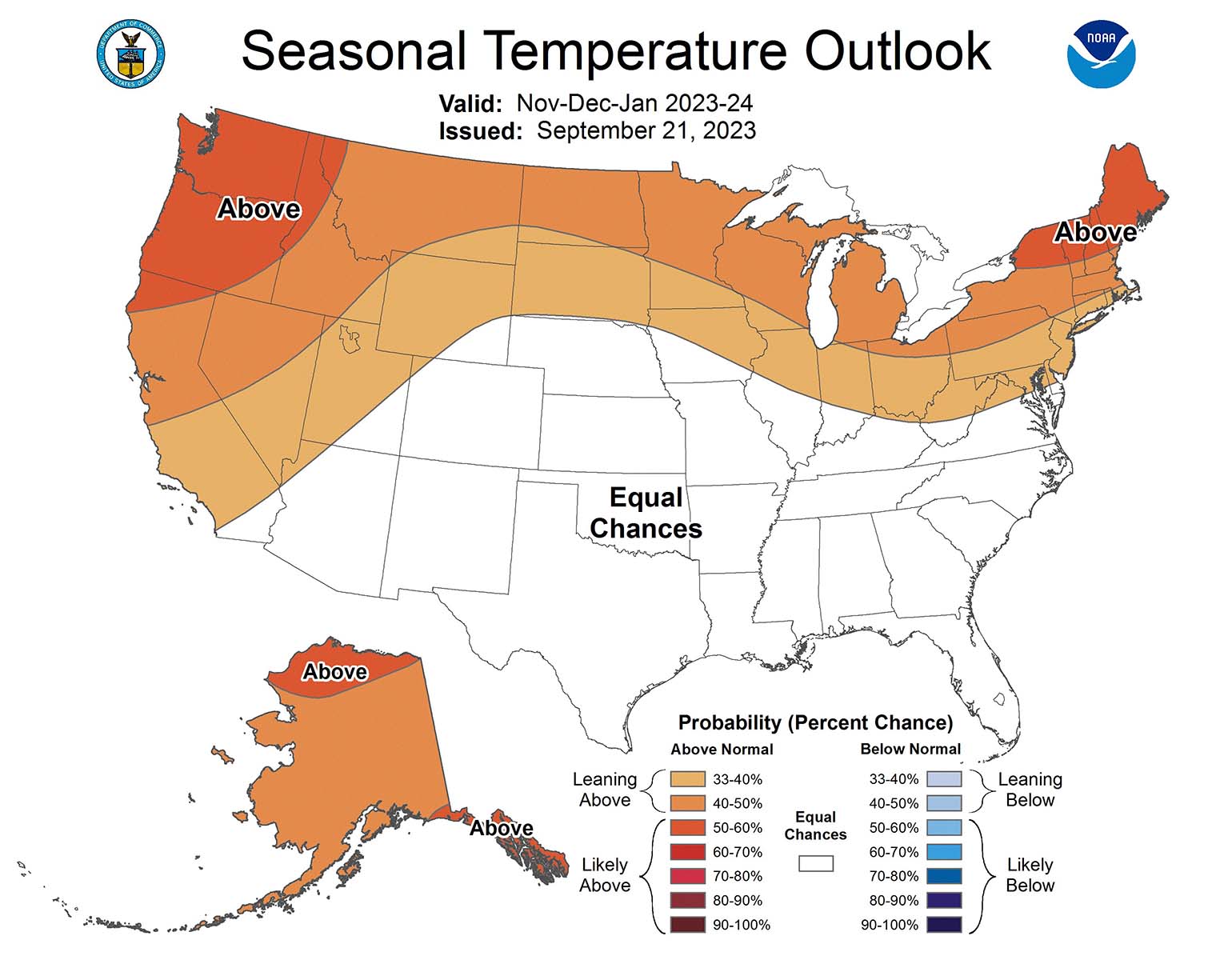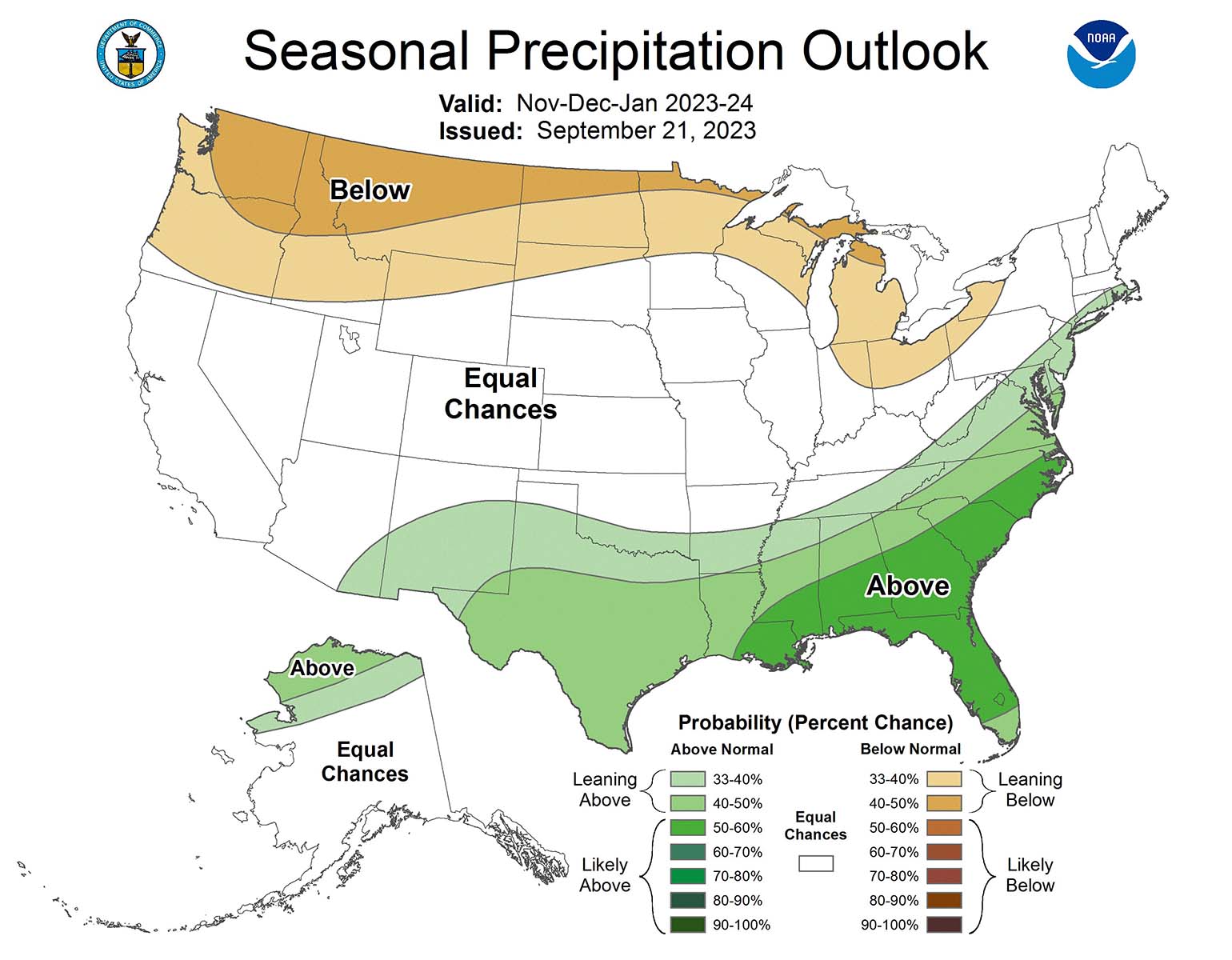HVAC contractors will have El Nino to thank — or blame — for the weather conditions against which they and the equipment they install and service will be working during the 2023-2024 heating season.
El Nino, a combination of weak surface winds across the tropical Pacific and warmer-than-normal water temperatures in the central and eastern tropical Pacific, will affect global atmospheric conditions, and thus U.S. weather patterns, this winter, according to several forecasts.
An El Nino typically brings above-normal temperatures to the Northern U.S. but below-normal cool to much of the Southwest and the South, from New Mexico and Texas to the Carolinas, according to the National Oceanic and Atmospheric Administration (NOAA). In addition, NOAA says, an El Nino typically brings more precipitation to a broad swath of the southern U.S., from Central and Southern California all the way into Virginia.
“We’re anticipating a strong El Nino by the start of the winter season,” said Paul Pastelok, senior meteorologist at AccuWeather. “So that should be more wet weather along the Gulf Coast and Southeast. Unfortunately, there could be severe storms, like in Florida, Georgia ... and ice near the Tennessee Valley.”
“Get ready for a wet winter, with about 80 percent of the country expecting above-average snowfall,” said Sarah Perrault, a senior editor at The Old Farmer’s Almanac, which has issued weather predictions for more than 200 years and claims an average accuracy rate of about 80%.
NOAA announced in June that El Nino conditions had been detected. That followed three years in a row of a La Nina, which is the opposite condition — stronger surface winds and cooler temperatures across the tropical Pacific — and usually means colder, wetter weather across much of the Northern U.S. and drier, warmer conditions in the South, according to NOAA.
While above-normal temperatures in some parts of the U.S. could mean less work for HVAC companies, Pastelok said El Nino should mean increased use of heating systems in places like northern Arizona and northern New Mexico, and southern Utah and southern Colorado. In addition, he said, much of the South Central and Southwestern U.S. has been under drought conditions, and El Nino could bring much-needed precipitation.
The National Weather Service (NWS), a division of NOAA, has issued broad temperature and precipitation forecasts for the Continental U.S. for November, December, and January. (See maps.)

Click map to enlarge
WEATHER MAP: The National Weather Service says the shaded areas on this map are more likely than not to experience above-normal temperatures in November, December, and January, while the area in white has an even chance of seeing either above- or below-normal temperatures. (Map courtesy of the National Weather Service)

Click map to enlarge
CHANCE OF RAIN: The areas shaded in brown are tending toward below-normal precipitation for November, December, and January, the areas in white have an equal chance of either below- or above-normal precipitation, and the areas in green are leaning toward, or likely to have, above-normal precipitation, according to the National Weather Service. (Map courtesy of the National Weather Service)
The ACHR NEWS recently spoke to Pastelok and The Old Farmer’s Almanac’s Perrault to get more detailed forecasts for different regions of the country. And while the AccuWeather and Almanac predictions don’t always match up, Pastelok and Perrault said both are taking into account the impact of this year’s El Nino.
Northeast
According to Pastelok, temperatures should cool in late October, while November will bring ups and downs, but “not spectacularly chilly or anything like that.” Some polar air should arrive in December and January, he said. “It’s not as active as far as arctic air and severe cold,” he said.
But, he added, “toward the back end of winter, things get really nasty, much colder” and the possibility of storms in February and March will be higher.
The Almanac, Perrault said, predicts temperatures in the Northeast will be “above normal, but by no means warm.” Late November, early to mid-January, and early to mid-February are likely to be the coldest periods, she said, and precipitation and snowfall are supposed to be above normal.
Southeast
Because of the effects of El Nino, Pastelok said, the region should see a wetter season, with a high probability of severe weather, particularly in Georgia, Florida, and the Carolinas. El Nino could also bring ice to the Southeast, he said, especially in the interior, around the Tennessee Valley.
Perrault said the Almanac’s prediction is for above-normal temperatures, with the coldest periods in late December and early and mid-February. Precipitation and snowfall will also be above normal, she said.
Midwest
The region will see milder temperatures, Pastelok said, and not as much snow as some states, such as Iowa, Wisconsin, and Minnesota, were hit with last winter, which could suppress the demand for heating.
“I’m a little concerned that we will have some cold surges in February and March,” he said. “So we may get some extra heating on the back end. But most of the heart of the winter season, it’s not as bad as compared to normal.”
The Almanac, however, predicts below-normal temperatures for both the Upper and Lower Midwest, with the coldest periods in late November, all of December, and early and late January in the Upper Midwest; and in early and late December, early and late January, and early February in the Lower Midwest. Precipitation and snowfall will be above normal in the Upper Midwest, slightly above normal in the Lower Midwest, Perrault said.
Deep South
“Winter will be colder than normal in northern areas of the Deep South and warmer than normal in the southern parts,” said Perrault. “Coldest temperatures are expected in late December, early January, late January, and again in early February.” Precipitation will be above normal, with a chance of snow in the northern part of the region in mid- and late January and mid-February, she said.
Texas and Oklahoma
Texas should get below-normal temperatures and more precipitation, a change from the “heat dome” it’s been sweltering under, and there may be some ice and snow in the northwest part of the state and in Oklahoma, Pastelok said. “Overall, it should be cooler, it should be wetter, which is good news for the drought,” he said.
Southwest
According to the Almanac, winter will be cooler than normal, with the coldest periods coming in late December and late January. “Precipitation is forecast to be above normal, as will be snowfall in areas of this region that typically have snow,” Perrault said.
“Generally, California and Northern Arizona do very well,” said Pastelok. “In strong El Ninos, they usually get hit pretty hard with heavier rain and snow, and the temperatures are held down a bit because of that. It’s not terribly cold, but it’s just very active.”
Pastelok isn’t putting all his money on that bet, however, saying that AccuWeather is waiting on some other indicators before making a more complete projection. “We go back to 2015-15 when we were in an El Nino, and California didn’t get hardly any rain. It was well below normal,” he said. “So it doesn’t always happen that way.”
West
“The interior Northwest, Northern Rockies, and in those places, they seem to be missing out — kind of like the Midwest — on a lot of the action this year compared to what they normally get in a winter season,” said Pastelok. “So less than snowy, less cold, less demand, compared to their averages, for heating in that part of the country.”
Further south, though, in parts of Utah and Colorado, “they’re included in some of the Southern-tier storm track stuff,” Pastelok added. “They’re going to have periods throughout the winter where it gets pretty active, and that’s going to keep temperatures down below normal.”
At the Almanac, Perrault said the forecast calls for cooler and wetter weather than normal in the West, with above-normal snowfall in the mountains. The coldest spells will be in late November and early and late December, and above-normal precipitation is expected in January, February, and March.
Pacific Northwest
The region’s weather is influenced by air from the Pacific, which doesn’t get that cold, Pastelok said, adding that the weather should stick around its winter averages. “They can get a little more rain and snow in the Cascades compared to inland areas,” he said. “But I’m not expecting severe cold in that part of the country at this point.”
Perrault, however, said temperatures and precipitation in the region will generally be below normal levels. The coldest periods will be in mid-November, late December, and mid-January, she said, and some above-normal precipitation is expected in mid- to late December and mid-January.


Report Abusive Comment